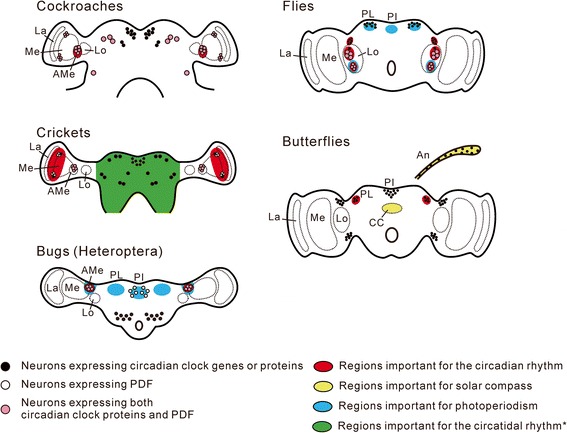Figure 3.

Neurons or regions important for the circadian rhythm, solar compass, photoperiodism, and circatidal rhythm. In cockroaches, the accessory medulla containing PDF-expressing neurons is the location of the circadian clock regulating activity rhythms [71,73]. In crickets, the circadian clock is located in the lamina and medulla regions [74]. *It is likely that the circatidal clock is not located in the optic lobe, but is probably located in the central brain [28], although the possibility that the clock is located in an extra-brain region cannot be excluded. In Rhodnius prolixus (Heteroptera), lateral neurons, which co-express clock proteins and PDF, are considered to be the circadian clock that regulates the activity and hormone-release rhythms [75,76]. The region containing these neurons is involved in the photoperiodic diapause in another heteropteran, Riptortus pedestris [77]. The PI and PL regions are also important for photoperiodic diapause in heteropterans [78,79]. In flies, among neurons expressing clock proteins in the brain, several groups of lateral neurons control the circadian activity rhythm. One group of neurons that co-express clock proteins and PDF is important for photoperiodism [80]. Neurosecretory cells in the PI and PL regulate photoperiodic diapause [81]. In butterflies, the PL is the main location of the circadian clock in the brain [82,83]. Neurons necessary for the solar compass are located in the central complex, and the circadian clock in the antennae is necessary for time compensation of the solar compass system [84,85]. Note that the neuronal location may differ among species. La, lamina; Me, medulla; AMe, accessory medulla; Lo, lobula; PI, pars intercerebralis; PL, pars lateralis; CC, central complex; An, antenna.
